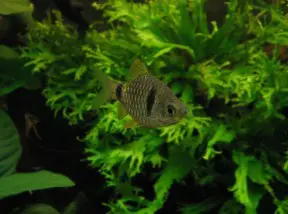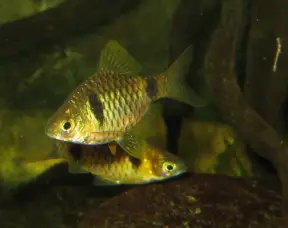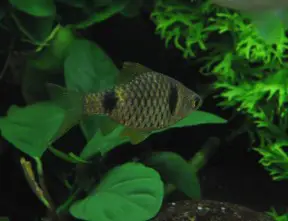Pethia cumingii
Cuming's Barb
SynonymsTop ↑
Barbus cumingii Günther, 1868; Puntius cumingii (Günther, 1868)
Etymology
Pethia: the generic vernacular name for small cyprinids in the Sinhala language.
cumingii: named in honour of British natural history collector Hugh Cuming (1791-1865), from whom the type series was purchased.
Classification
Order: Cypriniformes Family: Cyprinidae
Distribution
Endemic to southwestern Sri Lanka where it appears to occur only in the Bentara and Gin river drainages.
Historical records from the Kelani and Mahaweli rivers, further north, are now considered to represent the closely-related P. reval (Meegaskumbura et al., 2008).
Reports suggest that the more brightly-coloured fish are becoming scarcer and there exists a possibility that selective collection for the aquarium trade have altered the structure of wild populations.
That said, very little of the country’s forest cover remains due to human activities, with the result that habitat and water quality have been heavily degraded and numerous native fish species are now considered at risk of extinction.
Habitat
Apparently displays a preference for flowing streams and tributaries with substrates of sand, gravel, or rocks.
Maximum Standard Length
The largest officially-recorded specimen measured 41.2 mm.
Aquarium SizeTop ↑
Base dimensions of at least 60 ∗ 30 cm or equivalent are required.
Maintenance
Choice of décor is not especially critical though it tends to show better colouration in a heavily-planted set-up with a dark substrate.
The addition of some floating plants and driftwood roots or branches to diffuse the light entering the tank also seems to be appreciated and adds a more natural feel.
Filtration does not need to be particularly strong though it does seem to appreciate a degree of water movement and will also do well in a hill stream-type set-up.
Water Conditions
Temperature: 20 – 27 °C
pH: 5.5 – 7.0
Hardness: 18 – 215 ppm
Diet
Wild fish are foragers feeding on diatoms, algae, organic detritus, small insects, worms, crustaceans, and other zooplankton.
In the aquarium it’s easily-fed but the best condition and colours offer regular meals of small live and frozen foods such as bloodworm, Daphnia, and Artemia, alongside good quality dried flakes and granules, at least some of which should include additional plant or algal content.
Behaviour and CompatibilityTop ↑
Generally very peaceful making it an ideal resident of the well-researched community aquarium.
As it places no special demands in terms of water chemistry it can be combined with many of the most popular fish in the hobby including other small cyprinids as well as tetras, livebearers, rainbowfishes, anabantoids, catfishes, and loaches.
It’s a schooling species by nature meaning at least 6-10 specimens should be purchased.
Maintaining it in such numbers will not only make the fish less skittish but result in a more effective, natural looking display, plus males will develop better colours in the presence of conspecific rivals.
Sexual Dimorphism
Adult males are noticeably smaller, slimmer, and more colourful than females, especially when in spawning condition.
Reproduction
Like most small cyprinids Pethia spp. are egg-scattering free spawners exhibiting no parental care.
When in good condition they will spawn often and in a mature aquarium it’s possible that small numbers of fry may start to appear without intervention.
However if you want to maximise yield a more controlled approach is required.
The adult group can still be conditioned together but a smaller aquarium should also be set up and filled with mature water.
This should be very dimly lit and the base covered with some kind of mesh of a large enough grade so that the eggs can fall through but small enough so that the adults cannot reach them. The widely available plastic ‘grass’-type matting can also be used and works well, as does a layer of glass marbles.
Alternatively filling much of the tank with a fine-leaved plant such as Taxiphyllum spp. or spawning mops can also return decent results.
The water itself should be of slightly acidic to neutral pH with a temperature towards the upper end of the range suggested above, and an air-powered sponge filter or air stone(s) should also be included to provide oxygenation and water movement.
When the adults are well-conditioned and the females appear gravid one or two pairs should then be introduced, and spawning should take place the following morning.
An alternative is to spawn the fish in a group with half a dozen specimens of each sex being a good number, although a larger aquarium may be necessary.
In either situation the adults will probably eat the eggs given the chance and should be removed as soon as any are noticed.
These should hatch in 24 – 48 hours with the fry free swimming around 24 hours later.
They should be fed on an infusoria-grade food for the first few days until large enough to accept microworm, Artemia nauplii, or suchlike.
NotesTop ↑
This species was for many years considered to occur in two colour forms with yellow or red dorsal, anal, and pelvic fins, respectively, but the red-finned variant has now been elevated to full species status as P. reval (Meegaskumbura et al., 2008).
The latter is a smaller fish with a maximum SL of 33.6 mm recorded to date.
As well as the obvious differences in body size and fin colour P. cumingii can be told apart from P. reval by the following combination of characters: eye diameter 10.8 – 12.1 % SL (vs. 9.8 – 10.5 % SL in P. reval); 11+15 vertebrae (vs. 11+13); cleithrum smooth (vs. possessing a single spine); proximal arm of fifth ceratobranchial with an oval foramen of diameter greater than (vs. less than) basal diameter of teeth.
The two also differ in distribution and habitat with P. cumingii occurring in mid-to-upper reaches of southwestern drainages and P. reval tending to inhabit sluggish, lowland sections of west-flowing rivers.
P. cumingii was formerly included in the Puntius conchonius ‘group’ of closely-related species alongside P. ater, P. bandula, P. conchonius, P. didi, P. erythromycter, P. gelius, P. khugae, P. macrogramma, P. manipurensis, P. meingangbii, P. nankyweensis, P. nigripinnis, P. nigrofasciatus, P. padamya, P. phutunio, P. punctatus, P. reval, P. shalynius, P. stoliczkanus, P. thelys, P. tiantian, and P. ticto, but all of these were moved to the new genus Pethia by Pethiyagoda et al. (2012) as were P. melanomaculata, P. pookodensis, P. muvattupuzhaensis, P. ornatus, and P. yuensis.
‘Puntius‘ narayani was not moved to the new genus and is currently of uncertain generic placement since it uniquely possesses 9 branched dorsal-fin rays and 6 branched anal-fin rays.
Pethia species are defined by the following combination of characters: rostral barbels absent; maxillary barbels minute or absent; possession of a stiff, serrated last unbranched dorsal-fin ray; presence of a black blotch on the caudal peduncle, and frequently, black blotches, spots or bars on the side of the body; infraorbital 3 deep and partially overlapping the preoperculum.
In P. cumingii the flank markings comprise two black, vertically-orientated blotches, one posterior to the operculum and the other on the caudal peduncle, and this patterning is shared with the congeners P. bandula, P. didi, P. meingangbii, P. padamya, P. phutunio, P. tiantian and the aforementioned P. reval.
P. cumingii is distingushed from these by its yellow fin colouration plus the following combination of characters: barbels absent; dorsal-fin ray osseous and serrated proximally, flexible distally; lateral line short (5-6 perforated scales); 18 lateral scale rows (vs. 19 or more in other species); 10 circumpeduncular scales (vs. 12); 3½ scales above midline (vs. 4½). Kullander and Fang (2005) also noted that it should possess 13 gill rakers as per Jayaram (1991) but that the single specimen they examined had only 5.
The genus Puntius was for a number of years viewed as a polyphyletic catch-all containing over 100 species of small to mid-sized cyprinid until Pethiyagoda et al. (2012) published a partial review covering South Asian members.
The majority of sub-Himalayan Puntius species were reclassified and new genera Dawkinsia, Dravidia, and Pethia erected to accomodate some of them, with the remainder either retained in Puntius or moved to the existing Systomus assemblage, though the definition of the latter was altered meaning some Southeast Asian species formerly placed there are no longer members.
It subsequently became clear that the name Dravidia was preoccupied by a genus of flesh fly, therefore the replacement name Haludaria was made available by Pethiyagoda (2013).
No species from Indochina, China, or Indonesia were included in the study meaning a significant number of former Puntius are currently classed as incertae sedis, i.e., of uncertain taxonomic placement, and this also applies to a number of South Asian species of unresolved status.
They’re perhaps best referred to as ‘Puntius‘ for the time being whereby the genus name is surrounded by quotation marks to denote its questionable usage, and that is the convention used here on SF at the moment.
References
- Günther, A., 1868 - Catalogue of the fishes in the British Museum v. 7: i-xx + 1-512
Catalogue of the fishes in the British Museum. Catalogue of the Physostomi, containing the families Heteropygii, Cyprinidae, Gonorhynchidae, Hyodontidae, Osteoglossidae, Clupeidae,... [thru]... Halosauridae, in the collection of the British Museum. - Kullander, S. O. and F. Fang, 2005 - Copeia 2005(2): 290-302
Two new species of Puntius from northern Myanmar (Teleostei: Cyprinidae). - Kullander, S. O. and R. Britz, 2008 - Electronic Journal of Ichthyology, Bulletin of the European Ichthyology Society 2: 56-66
Puntius padamya, a new species of cyprinid fish from Myanmar (Teleostei: Cyprinidae). - Marcus Knight, J. D., K. Rema Devi, T. J. Ingram, and M. Arunachalam, 2012 - Journal of Threatened Taxa 4(3): 2409-2416
A new species of barb Puntius nigripinnis (Teleostei: Cyprinidae) from southern Western Ghats, India. - Meegaskumbura, M., A. Silva, K. Maduwage, and R. Pethiyagoda, 2008 - Ichthyological Exploration of Freshwaters 19(2): 141-152
Puntius reval, a new barb from Sri Lanka (Teleostei: Cyprinidae). - Pethiyagoda, R., 2013 - Zootaxa 3646(2): 199
Haludaria, a replacement generic name for Dravidia (Teleostei: Cyprinidae). - Pethiyagoda, R., M. Meegaskumbura, and K. Maduwage, 2012 - Ichthyological Exploration of Freshwaters 23(1): 69-95
A synopsis of the South Asian fishes referred to Puntius (Pisces: Cyprinidae).



